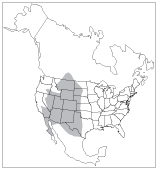|
Pronghorn Antelope | Pronghorn Antelope Overview | Pronghorn Antelope Damage Assessment | Pronghorn Antelope Damage Management | Pronghorn Antelope Resources | Pronghorn Antelope Acknowledgments | ICWDM | Wildlife Species Information |

Figure 1. Pronghorn antelope, Antilocapra americana
Contents |
Identification
The pronghorn (Antilocapra americana) is not a true antelope but in a family by itself (Antilocapridae). It is native only to North America.
The pronghorn is the only North American big game animal that has branched horns, from which its name derives. Pronghorns have true horns — derived from hair — not antlers. The horns have an outer sheath of fused, modified hair that covers a permanent, bony core. Pronghorns shed the hollow outer sheath each year in October or November and grow a new set by July. Both bucks and does have horns, but doe horns are shorter and more slender. Adult pronghorns stand 3 feet (90 cm) high at the shoulders. Bucks weigh about 110 pounds (50 kg); does weigh about 80 pounds (36 kg). Pronghorns have a bright reddish-tan coat marked with white and black. The buck has a conspicuous black neck patch below the ears, which is lacking on the doe. At a distance, their markings break up the outline of their body, making them difficult to see. Their white rump patch is enlarged and conspicuous when they are alarmed. The flash of white serves as a warning signal to other pronghorns and is visible at long distances.
General Biology, Reproduction, and Behavior
Pronghorns depend on their eyesight and speed to escape enemies. Their eyes protrude in such a way that they can see in a side direction. They prefer to live on the open plains where they can see for long distances. Pronghorns are the fastest North American big game animal and can reach speeds of up to 60 miles per hour (96 kph).
Pronghorns are social animals, gathering in relatively large herds. In spring, however, bucks are alone or form small groups. Pronghorns breed during September and October. Bucks are polygamous, collecting harems of 7 to 10 does, which they defend from other bucks. Bucks and does begin breeding at 15 to 16 months of age. Usually 2 kids (young) are born 8 months after mating. The kids are grayish brown at birth and usually weigh 5 to 7 pounds (2.3 to 3.2 kg). Does nurse their kids and keep them hidden until they are strong enough to join the herd, usually at 3 weeks of age. By fall, the kids can take care of themselves and are somewhat difficult to distinguish from adults.
Pronghorns are relatively disease and parasite-free. Losses occur from predation, primarily coyote, and starvation during severe winters with prolonged deep snow.
|
Pronghorn Antelope | Pronghorn Antelope Overview | Pronghorn Antelope Damage Assessment | Pronghorn Antelope Damage Management | Pronghorn Antelope Resources | Pronghorn Antelope Acknowledgments | ICWDM | Wildlife Species Information |
Range

Pronghorns currently have a scattered but widespread distribution throughout western North America (Fig. 2). In the early 1800s, when the Lewis and Clark expedition recorded the presence of large herds of pronghorn, the total population across North America was estimated at 35 million. In less than 100 years, however, intensive market hunting brought pronghorn numbers to a low of approximately 13,000. Quick action by conservation-minded leaders saved the pronghorn from possible extinction.
In the late 1800s and early 1900s most Great Plains state legislatures passed laws making it unlawful to kill, ensnare, or trap pronghorns.
Pronghorns were given complete protection for nearly 50 years. In the 1940s and 1950s, limited hunting seasons were permitted, and pronghorn sea-sons have been held ever since in most Great Plains states. Populations have shown a notable increase in the last 2 decades.
A game management success story documents an increase from a population low of a few bands of pronghorn in Nebraska during the early 1900s to a current population of about 7,000. Trapping and transplanting programs to reestablish pronghorn populations by the state wildlife agencies and proper management and protection have been major factors in the pronghorn’s recovery.
Habitat
Pronghorns thrive in short and mixed grasslands and sagebrush grasslands. They prefer rolling, open, expansive terrain at elevations of 3,000 to 6,000 feet (900 to 1,800 m), with highest population densities in areas receiving an average of 10 to 15 inches (25 to 38 cm) of precipitation annually. Vegetation heights on good pronghorn ranges average 15 inches (38 cm) with a minimum of 50% ground cover of mixed vegetation. Healthy pronghorn populations are seldom found more than 3 to 4 miles (4.8 to 6.4 km) from water.

Pronghorns sometimes migrate between their summer and winter ranges. Since they seldom jump over objects more than 3 feet (90 cm) high, most fences stop them unless they can go under or through them. The construction of many highways with parallel fencing has greatly altered the migratory patterns of pronghorns. Woven wire fences, in particular, are a barrier that impede pronghorn movements to water, wintering grounds, and essential forage. Proper spacing of barbed wire in fences (Fig. 3) is essential to allow adequate pronghorn movement.
Food Habits
Pronghorns eat a variety of plants, mostly forbs and browse. Sagebrush often makes up a large part of their diet. They are dainty feeders, plucking only the tender, green shoots. Pronghorns compete with sheep for forbs, but are often found on summer cattle ranges where cattle eat the grasses, leaving the forbs and browse. Dietary overlap of pronghorns with sheep and cattle was 40% and 15%, respectively, in New Mexico. In the winter, pronghorns often feed in winter wheat and alfalfa fields.
Sandford D. Schemnitz. Professor. Wildlife Science. New Mexico State University
Las Cruces, New Mexico 88003
